|
 |
Subscribe to the Research Digest
or Read Online |
|
|
|
|
What's Climate Got To Do With It?
California's drought has dragged on for three years, but its potential connection to climate change is only now being revealed. A research team led by Stanford Woods Institute Senior
Fellow Noah Diffenbaugh (Environmental Earth System Science) determined that atmospheric conditions associated with the drought were at least three
times as likely to occur in the present climate as in the preindustrial climate. The study expands our understanding of climate change's connection to the extreme drought, and provides a resource to help
communities better prepare and adapt.
Read more...
Read on for more details about Diffenbaugh's research, and to explore other insights and discoveries on environmental challenges and solutions published by Stanford Woods Institute
fellows and affiliated researchers.
|
|
|
|
|
 |
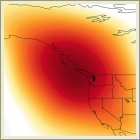 |
Causes of California Drought "Very Likely" Linked to Climate Change
The atmospheric conditions associated with the unprecedented drought currently afflicting California are "very likely" linked to human-caused climate change, according to a Stanford study. The research
team included lead author Daniel Swain, a graduate student in Environmental Earth System Science and a participant in the Woods Rising Environmental Leaders Program, Woods Senior Fellow Noah Diffenbaugh (Environmental Earth System Science) and Woods-affiliated Assistant Professor of Statistics and of Environmental Earth System Science Bala Rajaratnam. They used a novel combination of computer simulations and
statistical techniques to show that a persistent region of high atmospheric pressure hovering over the Pacific Ocean that diverted storms away from California was much more likely to form in the presence of
modern greenhouse gas concentrations. The research, published as part of a supplement to the October issue of the Bulletin of the American Meteorological Society, is one of the most comprehensive studies to
investigate the link between climate change and California's ongoing drought.
Photo credit: Courtesy of Daniel Swain
Read more...
The Extraordinary California Drought of 2013/2014: Character, Context and the Role of Climate Change," part of "Explaining Extreme Events of 2013 from a Climate Perspective," a special supplement to the Bulletin of the American Meteorological Society, September 2014 |
|
More
information about Stanford Woods Institute climate research |
|
 |
 |
New Research Links Malnutrition and Pollination
A new study by Natural Capital Project researchers, including Research Associate Becky Chaplin-Kramer, gives new urgency to efforts to stem the loss of pollinators such as bees. Their findings suggest the
contribution of pollinators to human nutrition is potentially much higher than previously thought. The research is particularly important to individuals in Southeast Asia, India, central and southern Africa and
Central America. People in these regions, areas of highest pollination dependence, are three times as likely to suffer micronutrient deficiencies.
Read more...
"Global Malnutrition Overlaps With Pollinator-Dependent Micronutrient Production," Proceedings of the Royal Society B, Sept. 17, 2014 |
 |
Biologist Warns of Mass Extinction's Early Stages
Although currently high, biodiversity on Earth may be reaching a tipping point. That's the consensus reached by an international team of scientists led by Senior Fellow, by courtesy, Rodolfo Dirzo (Biology). The
team cautions that the human-caused loss and decline of animals is contributing to what appears to be the early days of the planet's sixth mass biological extinction event. Potential solutions include immediate
and carefully tailored reductions in rates of habitat change and overexploitation, as well as raising awareness of the situation to spur change.
Photo credit: Claudia Paulussen/Shutterstock
Read more...
"Defaunation in the Anthropocene," Science, July 25, 2014
|
|
Other Ecosystem Services and Conservation Research
"Loss of Avian Phylogenetic Diversity in Neotropical Agricultural Systems," Science, Sept. 12, 2014, co-authored by Senior Fellows Gretchen Daily (Biology) and Elizabeth Hadly (Biology) and Woods-affiliated
postdoctoral scholar Daniel Karp (Natural Capital Project)
"Alameda Song Sparrow Abundance Related to Salt Marsh Vegetation Patch Size and Shape Metrics Quantified from Remote Sensing Imagery," San Francisco Estuary and Watershed Science, September 2014, co-authored by Senior Fellow Steven Gorelick (Environmental Earth System Science)
"Agent-Based Modelling of Hunting and Subsistence Agriculture on Indigenous Lands: Understanding Interactions Between Human and Ecological Systems," Environmental Modelling and Software, August 2014, co-authored by Senior Fellow Eric Lambin (Environmental Earth System Science)
"Multiple Pathways of Commodity Crop Expansion in Tropical Forest Landscapes," Environmental Research Letters, July 22, 2014, co-authored by Senior Fellows Lisa Curran (Anthropology) and Eric Lambin (Environmental Earth System Science)
"Unresolved Issues in Pre-Meiotic Anther Development," Frontiers in Plant Science, July 21, 2014, co-authored by Woods-affiliated Professor of Biology Virginia Walbot
"Sequencing and de novo Assembly of a Dahlia Hybrid Cultivar Transcriptome," Frontiers in Plant Science, July 17, 2014, co-authored by Woods-affiliated Professor of Biology Virginia Walbot
"Effectiveness and Synergies of Policy Instruments for Land Use Governance in Tropical Regions," Global Environmental Change, 2014, co-authored by Senior Fellow Eric Lambin (Environmental Earth System Science)
|
|
More information about Stanford Woods Institute ecosystem services research |
|
 |
 |
How To Increase Farm Yields and Lower Pollution in China
Farming practices in China could be designed to simultaneously improve yields and reduce environmental damages substantially, according to a study by Senior Fellow Peter Vitousek (Biology) and a team of his
colleagues at China Agricultural University. They found that an integrated soil-crop system approach can yield almost exactly as much as a standard high-yield approach while requiring much less fertilizer and
significantly lower greenhouse gas emissions.
Read more...
"Producing More Grain With Lower Environmental Costs," Nature, Sept. 3, 2014 |
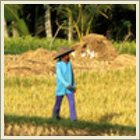 |
How to Feed the World
Local, national and global priorities and policies often conflict with one another and can thwart solutions to hunger. To shed light on the complexities of feeding the world, 19 Stanford experts, including 13
Woods-affiliated researchers, joined forces in a wide-ranging book project. Edited by William Wrigley Senior Fellow Rosamond Naylor (Environmental Earth System Science), director of the Center on Food Security
and the Environment, the volume draws on the authors' wealth of experience in fields including agricultural and developmental economics, environmental and earth science, law, medicine, engineering, education and
public policy. Chapter authors include Naylor, Senior Fellows Mariano-Florentino Cuéllar (Law), Jenna Davis (Civil and Environmental Engineering), Chris Field (Biology, Environmental Earth System
Science), Eric Lambin (Environmental Earth System Science), David Lobell (Environmental Earth System Science), Pam Matson (Earth Sciences), Buzz Thompson (Law) and Peter Vitousek (Biology); Senior Fellow,
emeritus, Walter Falcon (Freeman Spogli Institute for International Studies); Research Associate Amy Pickering (Water, Health and Development); Woods-affiliated Assistant Professor of Medicine Eran Bendavid and
Woods-affiliated Professor in International Agricultural Policy Scott Rozelle.
Read more...
"The Evolving Sphere of Food Security," Oxford University Press, September 2014 |
|
Other Food Security Research
"Does Aquaculture Add Resilience to the Global Food System?" PNAS, Sept. 16, 2014, co-authored by Senior Fellows Rosamond Naylor (Environmental Earth System Science) and Paul Ehrlich (Biology) and Woods-affiliated Professor of Economics and Operations Research, emeritus, Kenneth Arrow
|
|
More information about Stanford Woods Institute food security research |
|
 |
 |
Groundwater: Ignore It, and It Might Go Away
Because groundwater is hidden beneath the earth's surface, for many Californians it's a matter of "out of sight, out of mind." Residents often take groundwater for granted and do not realize that it is
a critical resource, providing 40 percent of the state's water supply during normal years and as much as 60 percent during dry times – like now. A team of Water in the West researchers compiled a
multimedia research project to help Californians understand the importance of groundwater in the state, the problems caused by groundwater overdraft and potential solutions for addressing those problems.
Photo credit: Chris Austin
Read more...
"Understanding California's Groundwater" (Report), July 31, 2014 |
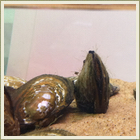 |
Clams and Clean Water
Pharmaceuticals, personal care products, herbicides and flame retardants are increasingly showing up in waterways. These chemicals are found in some waters at trace levels; little is known about their ecosystem
health impacts. But some have been implicated as potentially harmful to fish reproduction in waters receiving large inputs of wastewater. A Stanford study co-authored by Senior Fellow, by courtesy, Richard Luthy (Civil and Environmental Engineering) finds that a natural, low-cost solution – clams and mussels – may already exist for these contaminants of emerging concern, or CECs. In the right quantities,
bivalves such as clams and mussels can remove some CECs from water in a matter of days, according to the research.
Photo credit: Niveen Ismail
Read more...
"Uptake of Contaminants of Emerging Concern by the Bivalves Anodonta californiensis and Corbicula fluminea, "Environmental Science and Technology, July 13, 2014 |
|
Other Freshwater Research
"The Path to Water Innovation" (Report), Oct. 20, 2014, co-authored by Woods Co-Director and Senior Fellow Buzz Thompson (Law) and Senior Research Scientist Newsha Ajami (Water in the West)
"Disassembly and Reassembly of Polyhydroxyalkanates: Recycling Through Abiotic Depolymerization and Biotic Repolymerization," Bioresource Technology, October 2014, co-authored by Senior Fellow, by courtesy, Craig Criddle (Civil and Environmental Engineering) and Woods-affiliated Professor of Chemistry Robert Waymouth
"Groundwater Extraction, Land Subsidence, and Sea-Level Rise in the Mekong Delta, Vietnam," Environmental Research Letters, Aug. 15, 2014, co-authored by Senior Fellow Steven Gorelick (Environmental Earth System Science) and Woods-affiliated Professor of Electrical Engineering and Geophysics Howard Zebker
"Anaerobic Treatment of Low-Strength Wastewater: A Comparison Between Single and Staged Anaerobic Fluidized Bed Membrane Bioreactors," Bioresource Technology, August 2014, co-authored by Woods-affiliated Professor of Civil Engineering, emeritus, Perry McCarty
"The Effect of Fluidized Media Characteristics on Membrane Fouling and Energy Consumption in Anaerobic Fluidized Membrane Bioreactors," Separation and Purification Technology, August 2014, co-authored by Woods-affiliated Professor of Civil Engineering, emeritus, Perry McCarty
|
|
More information about Stanford Woods Institute freshwater research |
|
 |
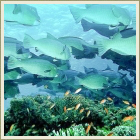 |
Scientists Challenge Theory on Protection of Threatened Species
An analysis co-authored by Senior Fellows Rob Dunbar (Environmental Earth System Science), William Durham (Anthropology) and Fiorenza Micheli (Biology) and Woods-affiliated Assistant Professor of Anthropology Doug Bird challenges a widely accepted theory that protecting threatened species with unique functional roles is synonymous with protecting ecosystems. In fact, the study's subject, the bumphead parrotfish, is a prime example of a threatened species that, in high numbers, can damage its surroundings. Instead of simply concentrating conservation efforts on the bumphead or any other threatened species, resource managers and policymakers should consider these species' diverse impacts and the forces that mediate them, according to the study's authors.
Photo credit: Jenny Huang
Read more...
"Positive and Negative Effects of a Threatened Parrotfish on Reef Ecosystems," Conservation Biology, October 2014 |
 |
Tracing the Loss of O From H2O
How are California's near-shore ocean waters different than waters farther offshore, and why does it matter? A study co-authored by Senior Fellows Fiorenza Micheli (Biology) and Larry Crowder (Biology) found that
the amount of dissolved oxygen has declined up to four times in near-shore waters during the past 15 years, a trend without precedent in half a century. The primary driving force behind the rapid change doesn't
appear to be climate variability, according to the researchers, but coastal biophysical processes such as increased phytoplankton biomass in surface waters, which utilize oxygen at high rates. What remains
unclear is whether these processes are a result of upwelling, the process by which water rises up from beneath the surface to replace water pushed away by wind, or human-caused nutrient inputs.
Photo credit: Aaron Strong
Read more...
"Patterns and Potential Drivers of Declining Oxygen Content Along the Southern California Coast," Limnology & Oceanography, July 2014 |
|
More information about Stanford Woods Institute oceans research |
|
 |
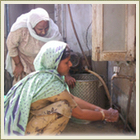 |
Low-Cost Health Savior: Soapy Water
In parts of the developed world where good hygiene can make a difference between life and death, soap is a luxury. A study co-authored by Senior Fellow Stephen Luby (Medicine) and Woods Research Associate Amy
Pickering (Water, Health & Development) finds that soapy water alone can provide an inexpensive and microbiologically effective cleansing agent to improve handwashing among households with vulnerable
children. The results are based on a field study of mothers in Dhaka, Bangladesh. In that study, soapy water and bar soap were found to remove potentially disease-spreading fecal bacteria similarly.
Read more...
"Microbiological Evaluation of the Efficacy of Soapy Water to Clean Hands: A Randomized, Non-Inferiority Field Trial," The American Journal of Tropical Medicine and Hygiene, August 2014 |
|
More information about Stanford Woods Institute public health research |
|
 |
 |
Fracking: The Good, the Bad and the Ugly
Hydraulic fracturing – the process of blasting huge amounts of water, sand and chemicals into underground rock formations to access oil or gas deposits – does not present a major threat to drinking-water aquifers, according to research led by Senior Fellow Robert Jackson (Environmental Earth System Science). The more likely culprits, the study finds, are failures in the steel and cement casings of wells
nearer to the surface and the disposal of wastewater. Through synthesis of academic studies and government databases, Jackson and his co-authors present various environmental costs and benefits of fracking, such
as its influence on local air pollution, earthquakes and, especially, supplies of clean water. Their findings underscore the consequences of policy decisions on people who live near fracking wells, and raise
important questions about how to reduce the environmental costs as much as possible, while making the most of environmental benefits.
Read more...
"The Environmental Costs and Benefits of Fracking," Annual Review of Environment and Resources, Aug. 11, 2014 |
 |
Connecting Virtual Reality and Environmental Behavior
Virtual reality, experiences that allow people to see, hear and feel digital stimuli as if they were in the physical world, holds the promise of changing environmental behavior, according to a study co-authored
by Senior Fellow Jeremy Bailenson (Communication). One experiment found that participants who cut a virtual tree went on to consume 20 percent less paper than participants who read a print description of tree
cutting. When interviewed a week later, participants in a second virtual reality experiment reported a greater perception that their behavior directly impacts environmental wellbeing, and reported more positive
environmental behaviors than participants exposed to print and video messages.
Read more...
"Short- and Long-Term Effects of Embodied Experiences in Immersive Virtual Environments on Environmental Locus of Control and Behavior," Computers in Human Behavior, October 2014 |
|
Other Sustainable Development Research
"Shifting Carbon Pools Along a Plant Cover Gradient in Woody Encroached Savannas of Central Argentina," Forest Ecology and Management, November 2014, co-authored by Senior Fellow Robert Jackson (Environmental Earth System Science)
"Noble Gases Identify the Mechanisms of Fugitive Gas Contamination in Drinking-Water Wells Overlying the Marcellus and Barnett Shales," Sept. 30, 2014, Proceedings of the National Academy of Sciences, co-authored by Senior Fellow Robert Jackson (Environmental Earth System Science)
"The Impact of Vivid Messages on Reducing Energy Consumption Related to Hot Water Use," Environment & Behavior, Sept. 29, 2014, co-authored by Senior Fellow Jeremy Bailenson (Communication)
"Betting on Negative Emissions," Nature Climate Change, Sept. 21, 2014, co-authored by Senior Fellow Robert Jackson (Environmental Earth System Science)
"Collaborative and Transformational Leadership in the Environmental Realm," Journal of Environmental Policy & Planning, Sept. 9, 2014, co-authored by Center Fellow Nicole Ardoin (Education)
"Risks and Risk Governance in Unconventional Shale Gas Development," Environmental Science and Technology, Aug. 5, 2014, co-authored by Senior Fellow Robert Jackson (Environmental Earth System Science)
"Priming of Soil Organic Carbon Decomposition Induced by Corn Compared to Soybean Crops," Soil Biology Biochemistry, August 2014, co-authored by Senior Fellow Robert Jackson (Environmental Earth System Science)
"A Roadmap for Repowering California for All Purposes With Wind, Water and Sunlight," Energy, August 2014, co-authored by Senior Fellow Mark Jacobson (Civil and Environmental Engineering)
"The Integrity of Oil and Gas Wells," Proceedings of the National Academy of Sciences, July 29, 2014, co-authored by Senior Fellow Robert Jackson (Environmental Earth System Science)
"Effects of Biomass Burning on Climate, Accounting for Heat and Moisture Fluxes, Black and Brown Carbon, and Cloud Absorption Effects," Journal of Geophysical Research: Atmospheres, July 21, 2014, co-authored by Senior Fellow Mark Jacobson (Civil and Environmental Engineering)
|
|
More information about Stanford Woods Institute sustainable development research |
|
|
|
|
Find Us on the Web
   |
|
The Stanford Woods Institute Research Digest is a quarterly report of findings by Woods fellows and affiliated faculty, as well as fellows with the Institute's Leopold Leadership Program. Current and past issues are online.
Contact us to subscribe or provide information about new and forthcoming research.
To learn more about the Stanford Woods Institute for the Environment, visit our website or email us.
Stanford Woods Institute for the Environment
Jerry Yang & Akiko Yamazaki Environment & Energy Building - MC 4205
473 Via Ortega
Stanford, CA 94305 |
|
|
|
